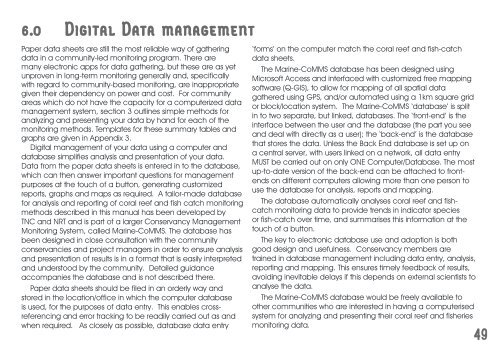TNC-CORDIO coral reef monitoring manual_book_coral1
TNC-CORDIO coral reef monitoring manual_book_coral1
TNC-CORDIO coral reef monitoring manual_book_coral1
You also want an ePaper? Increase the reach of your titles
YUMPU automatically turns print PDFs into web optimized ePapers that Google loves.
6.0 Digital Data management<br />
Paper data sheets are still the most reliable way of gathering<br />
data in a community-led <strong>monitoring</strong> program. There are<br />
many electronic apps for data gathering, but these are as yet<br />
unproven in long-term <strong>monitoring</strong> generally and, specifically<br />
with regard to community-based <strong>monitoring</strong>, are inappropriate<br />
given their dependency on power and cost. For community<br />
areas which do not have the capacity for a computerized data<br />
management system, section 3 outlines simple methods for<br />
analyzing and presenting your data by hand for each of the<br />
<strong>monitoring</strong> methods. Templates for these summary tables and<br />
graphs are given in Appendix 3.<br />
Digital management of your data using a computer and<br />
database simplifies analysis and presentation of your data.<br />
Data from the paper data sheets is entered in to the database,<br />
which can then answer important questions for management<br />
purposes at the touch of a button, generating customized<br />
reports, graphs and maps as required. A tailor-made database<br />
for analysis and reporting of <strong>coral</strong> <strong>reef</strong> and fish catch <strong>monitoring</strong><br />
methods described in this <strong>manual</strong> has been developed by<br />
<strong>TNC</strong> and NRT and is part of a larger Conservancy Management<br />
Monitoring System, called Marine-CoMMS. The database has<br />
been designed in close consultation with the community<br />
conservancies and project managers in order to ensure analysis<br />
and presentation of results is in a format that is easily interpreted<br />
and understood by the community. Detailed guidance<br />
accompanies the database and is not described there.<br />
Paper data sheets should be filed in an orderly way and<br />
stored in the location/office in which the computer database<br />
is used, for the purposes of data entry. This enables crossreferencing<br />
and error tracking to be readily carried out as and<br />
when required. As closely as possible, database data entry<br />
‘forms’ on the computer match the <strong>coral</strong> <strong>reef</strong> and fish-catch<br />
data sheets.<br />
The Marine-CoMMS database has been designed using<br />
Microsoft Access and interfaced with customized free mapping<br />
software (Q-GIS), to allow for mapping of all spatial data<br />
gathered using GPS, and/or automated using a 1km square grid<br />
or block/location system. The Marine-CoMMS ‘database’ is split<br />
in to two separate, but linked, databases. The ‘front-end’ is the<br />
interface between the user and the database (the part you see<br />
and deal with directly as a user); the ‘back-end’ is the database<br />
that stores the data. Unless the Back End database is set up on<br />
a central server, with users linked on a network, all data entry<br />
MUST be carried out on only ONE Computer/Database. The most<br />
up-to-date version of the back-end can be attached to frontends<br />
on different computers allowing more than one person to<br />
use the database for analysis, reports and mapping.<br />
The database automatically analyses <strong>coral</strong> <strong>reef</strong> and fishcatch<br />
<strong>monitoring</strong> data to provide trends in indicator species<br />
or fish-catch over time, and summarises this information at the<br />
touch of a button.<br />
The key to electronic database use and adoption is both<br />
good design and usefulness. Conservancy members are<br />
trained in database management including data entry, analysis,<br />
reporting and mapping. This ensures timely feedback of results,<br />
avoiding inevitable delays if this depends on external scientists to<br />
analyse the data.<br />
The Marine-CoMMS database would be freely available to<br />
other communities who are interested in having a computerised<br />
system for analyzing and presenting their <strong>coral</strong> <strong>reef</strong> and fisheries<br />
<strong>monitoring</strong> data.<br />
49


















